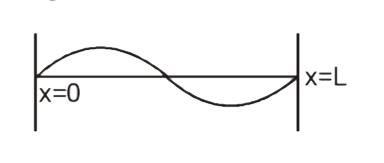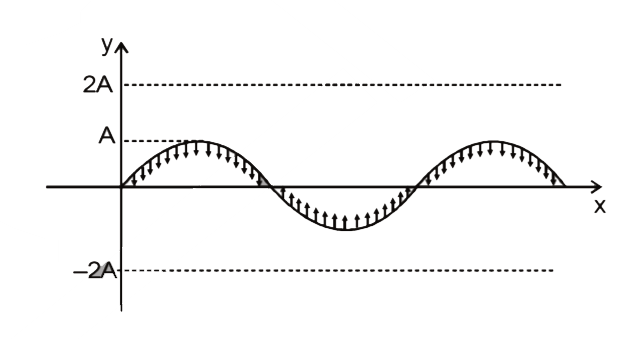Find out the equation of the standing waves for the following standing wave pattern.

General Equation of standing wave
y=A′cosωt
where
A′=Asin(kx+θ)
here λ =L
⇒k=2πL
A′Asin(kx+θ)=Asin(2πlx+θ)
at x=0 node
⇒A′=0atx=0
⇒θ=0
eq. of standing wave Asin(2π)Lxcosωt
Topper's Solved these Questions
- BOOK - MOTIONCHAPTER - WAVESEXERCISE - EXERCISE -1 (Objective Problems JEE Main)35videos
WAVES
- BOOK - MOTIONCHAPTER - WAVESEXERCISE - EXERCISE -2 (Level -I) (Objective Problems JEE Main)30videos
WAVES
- BOOK - MOTIONCHAPTER - WAVE OPTICS EXERCISE - EXERCISE - 4 (Level - II) Previous Year | JEE Main16videos
WAVE OPTICS
- BOOK - MOTIONCHAPTER - WORK, POWER & ENERGY EXERCISE - Exercise - 3 Section-B22videos
WORK, POWER & ENERGY
Similar Questions
Knowledge Check
- Question 1 - Select One
The equation of a transverse wave, out the following is
AX=asin(Kx−ωt)BY=asin(Ky−ωt)CY=asin(Kx−ωt)DZ=acos(Kz−ωt) - Question 2 - Select One
The equation of standing wave of the second resonance can be
 ,APex=2Asin2π(y=1cm)cos2π9340)tBPex=2Asin2π(y=1cm)cos2π9340)tCPex=2Asin2π(y=1cm)cos2π9340)tDPex=2Asin2π(y=1cm)cos2π9340)t
,APex=2Asin2π(y=1cm)cos2π9340)tBPex=2Asin2π(y=1cm)cos2π9340)tCPex=2Asin2π(y=1cm)cos2π9340)tDPex=2Asin2π(y=1cm)cos2π9340)t - Question 3 - Select One or More
In a standing wave on a string.
AIn one time period all the particles are simultaneously at rest twice.BAll the particles must be at their positive extremes simultaneously once in one time period.CAll the particles may be at their positive extremes simultaneously once in a time period.DAll the particles are never at rest simultaneously.
Energy OF travelling & standing waves
View SolutionStanding Waves In Roda
View SolutionAssume that the de-Brogile wave associated with an electron can form a standing wave between the atoms arranged in a one dimensional array with nodes at wach of the atomic sites. If is found that one such standing wave is formed if the distance 'd' between the atoms of the array is 2Å. A similar wave in again formed if 'd' is increased to 2.57 but not for any intermediate value of d. Find the energy of the electrons in electron volts and the least value of d for which the standing wave of the standing wave of the type described above can form.
View SolutionWhich of the following represents a standing wave ?
View SolutionWhich of the following represents a standing wave?
View Solution


